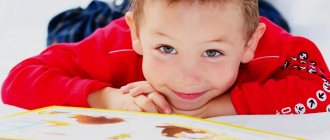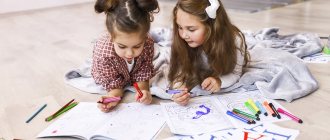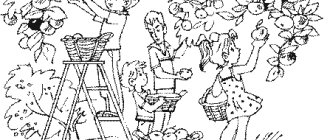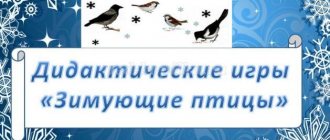- home
- Speech development
Teaching reading to preschoolers in a playful way is a fun and unusual way to conduct classes. In entertaining lessons, children do not just memorize letters and put them into syllables. They are completely immersed in the process, trying to complete as many interesting tasks as possible, and acquire the skill of reading without pressure from parents and teachers. We will tell you in our article which games to teach reading for older preschoolers to choose.
Age characteristics of preschoolers
Future first-graders aged 5-7 years are interesting creatures. They are curious about everything new, they absorb information well, but this period has its own characteristics. They should be taken into account before planning the workload and drawing up a work plan for a reading lesson:
- Kindergarten children speak well and constantly expand their vocabulary.
- Attention becomes voluntary.
- Kids love to reason and delve into the essence of a matter or question.
- Self-esteem and awareness of oneself as an individual grows.
- Play remains the main form of acquiring knowledge.
Learning to distinguish sounds in words
Teaching preschoolers to read begins with teaching the child to distinguish between vowels and consonants, hard and soft consonants. Vowels do not encounter obstacles on their way, they are formed only by the voice, they can be sung and extended. Observe how your teeth and lips behave when pronouncing a sound. If they put an obstruction, it is a consonant.
To hear the stressed sound in a word, you need to pronounce it with surprise or interrogatively, or “call” with this word: drum! umbrella? cat!
The peculiarity of the perception of a 4-5 year old child is that he needs to touch, take apart and put everything back together in order to understand. The same principle should be followed when studying sounds.
Literally sort words into sounds with your child. Let the vowels be red, and the consonants be blue cubes (without labels). Build word houses out of them. Say the word “juice” yourself, then have your child say it. Listen to the sounds, observe how the lips and teeth behave, at what moment they close.
Say the first sound - is it a vowel or a consonant? Place the first cube. Say the second sound - is it a vowel or a consonant? Lay out the second cube and “read” the diagram. Are all the sounds “lined up”? Say the third sound and complete the diagram. “Read” the diagram, check if all sounds are in place? When diagramming words consisting of two syllables, indicate the stress. Next we add the designation of hard and soft sounds.
When learning sounds, take into account the peculiarity of the Russian language: spelling does not always coincide with pronunciation. Therefore, first offer words in which each sound is in a strong position, i.e. can be heard well when spoken. For vowels, this is the position under stress; the vowel “u” is always clearly audible. Monosyllabic words (one syllable) with an unpaired consonant at the end or disyllabic words (two syllables) with the vowel “u” without stress or with “s” at the end of the word are suitable. For example, monosyllabic ones: sleep, chalk, forest, spruce, ball, table; disyllabic: foxes, museum, sail, etc.
Having mastered the decomposition of such words into syllables, you can move on to two- and three-syllable words, the spelling of which coincides with the pronunciation, for example: saw, nose, cat, giraffe, cat, grandmother, fireworks, etc. In the word “nose” at the end we hear the sound “s” ” and write the letter “s”, in contrast to the word “oak”, when pronounced we hear the sound “p”, but write the letter “b”.
Only later can you offer words whose spelling and pronunciation do not match: frost, family, oak, water, forests.
General training recommendations
The following simple recommendations from teachers and experienced parents will help you achieve success in learning to read:
- Make classes interesting, but full of new information. If a child gets bored, then attention will quickly switch to extraneous matters, conversations, objects. But this does not mean that a preschooler only needs to be entertained. Alternate games and serious tasks every 5-7 minutes.
- A variety of lesson forms will ensure high-quality knowledge acquisition. Don't use the same games. Little ones get bored with the same type of coloring books, puzzles, walkers, so make a rich library of games.
- It is better to exercise every day for 15 minutes than 2 times a week for an hour. Short daily lessons are more effective than lengthy learning sessions every now and then. Learning to read requires regular practice.
- Don't put pressure on children. Swearing, screaming, explanations bordering on hysteria and misunderstanding of the reasons for mistakes and difficulties in assimilating information lead to rejection. The child will hate school and books even before he gets to know them thoroughly.
- Take breaks for exercise. Switching attention is necessary to relax the brain and eyes.
- Use different forms of presenting something new. Presentations, interactive games, online testers.
- Play in class not for fun, but for the sake of an accessible form of presenting information. The choice of tasks should be approached taking into account the children’s progress in reading, the speed of grasping new things, and the level of general development.
Where to begin?
In fact, preparation for reading begins at a very early age. First of all, it’s worth starting not with reading itself, but with the child’s general cognitive development. Such development is greatly facilitated by simple logic problems, fine motor skills and speech improvement.
Some examples of games for 4 year olds
Continue the word. We learn to come up with words, develop imagination and speech.
When throwing the ball into your child’s hands, say the beginning of a word. For example, the syllable “Ma”. And the child, returning the ball to you, must continue it and say “Sha” or “Shina.” Be sure to pronounce the whole word afterwards: Masha or machine. Then complicate it a little and set a specific theme for the hidden words. For example, fruits, transport or names.
Sound riddle
Learning to develop memory and auditory attention
Prepare several children's musical instruments or toys: a pipe, a rattle, a bell, etc. Demonstrate all the sounds one by one so that the child remembers them. Then ask him to turn away and guess which object is making the sound now. Gradually make the game more difficult and alternate several sounds in turn
This game trains auditory attention, which is so necessary when learning to read.
Gift for a toy. We learn to identify the first letter in a word and develop imagination.
Celebrate your child's favorite toy. May it be her birthday today. Invite your child to choose a gift for the toy and draw it. The main condition of the game is that the first sound in the name of the gift is the same as the first sound in the name of the toy. For example, gifts for a doll begin only with the letter k: paints, xylophone, cubes. And for the bear - a ball, honey, a car. The more options the child names, the better.
A good aid in such a game would be pictures or cards with various objects depicted. Invite your child to pick up a gift and choose one of those shown in the picture.
This game helps develop the ability to analyze words soundly, which is necessary when reading.
Finish the drawing
We learn to complement figures, develop attention and fine motor skills. There are many options for drawing games
Draw simple and familiar objects to your child on a piece of paper, without specifically drawing in any significant details: a car without a wheel, a cat without a tail, a table without a leg, a teapot without a spout, etc. Invite your child to look carefully at the pictures and fill in the missing details. Such tasks allow you to develop logic and see objects as a whole.
Invite your child to unravel the “labyrinth”, that is, draw it from end to beginning, observing all the turns. Draw yourself how to do it. For a “labyrinth”, take a pencil or felt-tip pen of a light color, and for unraveling, a dark color. Thus, when completing the task, the maze will be repainted in a different color.
Draw various objects yourself and ask your child to look at the pictures and draw the same ones next to them.
Pay the child's attention to all the small details, size and location of the figures. Praise for the correctness and accuracy of completing the task. After consolidating the skill of drawing according to a model, invite your child to draw something from memory
It is better to start with simple images of geometric shapes or familiar objects. Give your child the opportunity to draw assignments for you. And when doing them, make a few mistakes on purpose - do not complete the detail or, on the contrary, come up with unnecessary ones. The child will enjoy finding and correcting your mistakes.
Drawing according to a model teaches the child to concentrate when working with signs, and also contributes to better memorization of letters and the correct reproduction of words when reading.
Game-based learning: pros and cons
Teaching a child to read at the age of 5-6, built in a playful way, has a lot of positive aspects. The effectiveness of the lessons can be explained by the age characteristics of older preschool children and the increased level of curiosity for everything new and bright.
Advantages of the method:
- The child does not get tired or lose interest in the process of receiving new information.
- Each lesson can be built according to an individual plan, choosing diverse tasks from a rich card index.
- The preschooler is directly involved in the creation of handouts and demonstration materials for the lesson. For example, draws letters, sculpts or cuts out of paper for applique.
- Reading is not brought to the forefront of the lesson. Letters, syllables, and words are learned gradually by the child.
- During game lessons, a child develops intellectually, creatively, and psychologically.
- The children's team unites.
- If the lesson is taught in a group, you can focus on the competitive aspect of the games. Children have a desire to do well, read and learn better than others.
Disadvantages of the method:
- The teacher may have problems with discipline. Excited children often play around and do not listen to the instructions of the teacher or parent.
- Games and puzzles take up a lot of time.
- The transition to traditional methods of presenting information necessary for learning to read is difficult for preschoolers to perceive; it takes time to switch attention.
This is interesting! In America and Israel, the game moment is necessarily included in every lesson with kindergarteners and primary schoolchildren. Teachers even take a special exam for the “ability” to teach while playing.
Before starting a reading course, draw up a rough work plan, a program for 6 months or a year:
- Start by learning and memorizing letters. Use Zaitsev's cube technique as an assistant.
- Automate their search and naming. Make crafts from plasticine, decorate letter symbols, choose words that have the same sound.
- Gradually combine sounds into syllables, invite your child to compose simple words on their own, look for them in pictures, and write. Play reading syllables, searching for letters, associations. This helps the sounds blend together.
- Read the words separately and in small sentences. At this stage, use tasks that involve finding names for pictures, solving puzzles, and crosswords.
- Try reading short texts. At the initial stage, select stories from the card index to read with your mother together, with pictures instead of words. Make the task more difficult gradually. Take Zhukova's ABC book to help.
Important! At 5-6 years old, do not demand reading speed from your child. The main task of teaching in the preschool period is skill automation. Tempo and technique will come on your own or with the help of special lessons later.
Methodology of Elena Bakhtina
Elena invites adults to teach their children how to form syllables on their own.
To do this, you need to print or draw cards with vowel and consonant sounds; they should differ in color. In a playful way, parents tell the child that the letters “G” and “A” met and became friends. The preschooler combines individual sounds into a syllable and remembers this sound combination. Throughout the day, the baby repeats the syllable, remembers it visually, looking at the card, and reinforces its pronunciation.
Day after day, the child learns new letter combinations, trains to pronounce them correctly, and remembers the varieties. To consolidate the result, you can use Chaplygin’s dynamic cubes, with the help of which the child makes pairs of vowels and consonants. The advantage of Chaplygin cubes is that they involve motor skills, which has a positive effect on the learning process.
Games
There are many interesting games for teaching reading to children 6-7 years old. We have collected the most exciting ones, those that preschoolers are sure to enjoy. Download the assignments from the website, print them on your home printer and study.
Learning letters
The preschooler's task: find pictures with a specific letter.
You need to select the images correctly: simple, understandable and familiar to the kindergartener.
You can start with these:
Kids can play individually or in pairs. In lesson 2-3, after learning a few letters, you can organize a competition.
Read by first letter
The game is unusual, but very effective for developing the speed of thinking and reading in the future. The child needs to remember the name of the objects, highlight the first letter in the word and pronounce only it, placing a card with the letter on the picture.
For example, take the first line on the form. Fox - Christmas tree - Sun. The preschooler should get a FOREST.
For variety, print out pictures for each pair of students rather than per class. Gradually make the game more difficult. Give children words of 4-5 letters.
Find the letter
The child is offered educational cards where the letters are mixed and printed in different fonts and formats. The preschooler's task is to find the desired sign and circle it with a pencil.
As an additional exercise: you can come up with a couple more words for a given letter, find objects in the room whose names begin with them. Use these fun cards for your lesson.
For children over 8 years old
Continue improving your reading speed in second grade. Eight-year-old children are independent and fast. They have outgrown the first grade activities, so offer them other fun exercises and games:
Looking for a word, line
The point of the game: the student finds all the words in the text that begin with the same letter. Searching for a whole phrase is a more complicated version of the task.
The exercise teaches attentiveness and develops the left hemisphere of the brain - the linguistic one.
Insert letters
A second grader is presented with a text with missing letters. To read it and understand it, you need to think of endings and prefixes.
This speeds up the pace of text comprehension in the future and helps to combine letters into whole words.
Fixing the error
The teacher reads the text, the children follow. The teacher deliberately makes a mistake in the ending of a word, root, etc. The student’s task is to correct the inaccuracy.
Read at speed
A second-grader independently takes measurements of reading technique, timing a minute, and keeps a diary of successes. Normally, by the second grade, children read at least 70 words, in the third - 100 words, in the fourth - 120.
Playing "Hidden Words"
The game is similar to reading anagrams. Children find words in the letter box. It looks like this:
Words can be selected on one topic or randomly. It is better for primary school students to provide a list of words that need to be found, leaving the task of isolating them on the field.
And one more option that you can print and use with your child.
Reading and counting
A second grader reads the text and counts the given sounds. For example, in the following poem, find out the number of “o” sounds.
Develops multitasking skills and concentration.
Tasks
Coloring books, puzzles, puzzles, and creative workshops increase a preschooler’s interest in the learning process and help create an atmosphere of friendship and understanding. Reading assignments have one important feature - they are multifunctional. Kids not only learn to read, but also develop motor skills, imagination, fantasy, thinking, and speech. It is simply impossible to do without interesting ideas for exercises and games for teaching reading to preschool children.
Find the letters and color them
Choose themed coloring pages. They may contain additional tasks, for example, color only those objects that begin with the letter “B”, color small images of letters, do not touch capital letters, etc.
Find the letters in the picture
Look at the picture and read
This task is suitable for children learning letters and reading syllables. Pictures with familiar objects can be shown in large quantities. Kids remember words well and use associations when reading without images.
After studying the words and relating them to objects, invite your preschooler to read the words without pictures. Familiar syllables form faster.
Reading syllable by syllable
For children who have mastered syllables well, short fairy tale texts are suitable. They can be read with parents or one at a time in class. After reading, be sure to ask your child what he understood and whether he can retell the text.
It is very important not to take boring, serious works for the lesson. It will be interesting for your child to learn the entire story of the characters from beginning to end in 3-4 sentences. In the process of reading such fairy tales, the teacher develops an interest in books in young students and a love for independent study of literature.
“Running” from one letter to another
(from “The ABC for Kids” by O. Zhukova)
This is a visual exercise that will help a child learn to pronounce two letters together.
Before us is a path from one letter to another. To overcome it, you need to pull the first letter until the finger we move along the path reaches the second letter. The main thing we are working on in this exercise is so that there is no pause between the first and second sound. To make it more interesting to practice, replace your finger with a figurine of any animal/person - let it run along the path and connect two letters.
Reasons for failure
A child may read slowly for several reasons:
- Undeveloped memory. This is not a pathology for a preschooler, so don’t be alarmed. It happens that a child, reading, for example, the fifth word in a line, forgets the first. Because of this, the idea is lost, the child does not understand what is said in the text, and as a result, interest is lost.
- If difficult words are encountered, the child stumbles and reads them slowly. The reason for this may also be poor functioning of the speech organs.
- Low concentration. The baby is easily distracted by various external factors, as well as by his own thoughts, and interest in reading dissipates.
- Vision angle. It often happens that a child does not see the whole word, but only a few of its letters. This slows down reading.
- Return to what you read. Often the young reader’s eyes return to the previous word or sentence, and he re-reads them.
- Inappropriate literature. Texts should be selected in accordance with the preferences and age of the child.
The ability to read well and quickly depends not only on the child’s intellectual abilities. It is worth taking into account psychological and physical abilities, diseases, and the environment (including in the family).
Often, learning is hampered by the child's lack of self-confidence and fear of making mistakes. Or he is simply bored while reading, the text is uninteresting.
Several ways to teach your child to read at home
Now we will talk about the technical side of the issue.
Has your baby become interested in the name of the store where you go to buy various goodies? This is a good sign! Don’t give up, start getting acquainted with the letters right on the spot. You just have to do it smartly.
Why are kindergartens against teaching at home? Because we don't know how to do it correctly!
At least that's what they think!
So you and I already know, because you are reading this article.
Thanks to this, it will be easier to merge them into syllables later.
“So, where to start, which method is right for my child? Do we need to hurry? - this is only part of the questions that plague modern mothers.
I looked through and re-read a lot of information. I was even afraid that I would get confused, because now the Internet is simply teeming with offers from various studios that offer to teach our children to read quite quickly. Who is telling the truth, and who is more profitable to “sell their services”?
And then, unexpectedly for myself, I came across a very interesting program. Believe me, I breathed a sigh of relief! There they sorted out all the pros and cons of early education.
A child's brain is like a sponge - it absorbs everything! You can almost easily put whatever you want into its little head. But a person must be able to think for himself! And for this it is simply necessary to develop, first of all, an analytical mindset.
Therefore, do not try to show pictures and ask them to name which letter the word begins with. It is not clear to them what you want! The baby is not stupid, he just has not yet developed the part of the brain that is responsible for this.
Why do children read poorly?
If a child does not improve his academic performance in the process of learning to read quickly, then you should understand the reasons. Ineffective learning is influenced by poor memory, absent-mindedness, and dislike of reading.
- If a child experiences regression of eye movements while reading (returning to the words read), then the adult should cover each word read with a ruler or bookmark.
- An insufficiently developed articulatory apparatus in a student or the presence of speech therapy problems means only one thing: parents should turn to speech pathologists or speech therapists.
The ability to understand, analyze and retell texts helps to learn
- Early development of these skills will help the preschooler prepare and adapt to school.
- The ability to work with text will make studying in primary school more interesting and useful.
- In grades 3-4, children with developed meaningful reading skills will find it easier and more interesting in Russian language and literary reading lessons.
- In middle and high school, experience in working with text will help you quickly absorb large amounts of new material, study well, and manage to do more than just school work.
Children need help coping with information overload. And soon we will implement this opportunity as part of our course.
Parental help
To help your baby, just follow a few rules:
- Interesting texts. Do not bombard a beginning reader with boring literature, even if it is educational. So that he does not give up reading, it must captivate him. Choose books according to his passions.
- Games. The reading process can be turned into a game in many ways. More about them below. You can also organize home competitions for the best reader.
- Read with your child regularly for 30 minutes a day.
- Personal example. It is difficult to instill a love for books in someone if you don’t love them yourself. Show by your own example that this is interesting and educational.
- Patience. Don't push, don't rush, show restraint and understanding.
Positive motivation. It is worth talking more about what a child will achieve in the future if he learns to read well. If you constantly repeat that he will grow up ignorant, provided that he does not read as expected, the result will be worse. Individuality of learning. As they say, you can’t cut everyone with the same brush. A method that works for one student may not work for another. The same goes for the pace of learning.
For everyone, it is chosen that is suitable, which is impossible to do at school, which is why it is so important to read at home.









